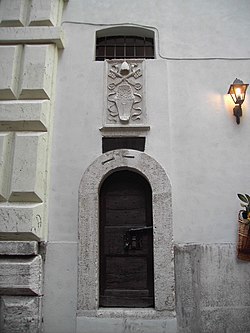Accademia di San Luca

The Accademia di San Luca (the "Academy of Saint Luke") is an Italian academy of artists in Rome. The establishment of the Accademia de i Pittori e Scultori di Roma was approved by papal brief in 1577, and in 1593 Federico Zuccari became its first principe or director; the statutes were ratified in 1607.: 30 Other founders included Girolamo Muziano and Pietro Olivieri. The Academy was named for Luke the Evangelist, believed to be the patron saint of painters. From the late sixteenth century until it moved to its present location at the Palazzo Carpegna, it was based in an urban block by the Roman Forum and although these buildings no longer survive, the Academy church of Santi Luca e Martina, does. Designed by the Baroque architect, Pietro da Cortona, its main façade overlooks the Forum.
Excerpt from the Wikipedia article Accademia di San Luca (License: CC BY-SA 3.0, Authors, Images).Accademia di San Luca
Piazza dell'Accademia di San Luca, Rome Municipio Roma I
Geographical coordinates (GPS) Address Nearby Places Show on map
Geographical coordinates (GPS)
| Latitude | Longitude |
|---|---|
| N 41.901666666667 ° | E 12.483611111111 ° |
Address
Accademia di San Luca
Piazza dell'Accademia di San Luca 77
00187 Rome, Municipio Roma I
Lazio, Italy
Open on Google Maps










